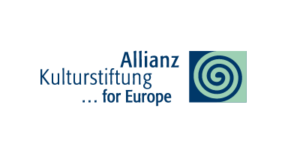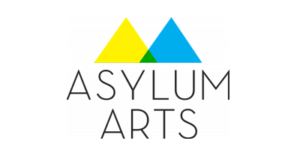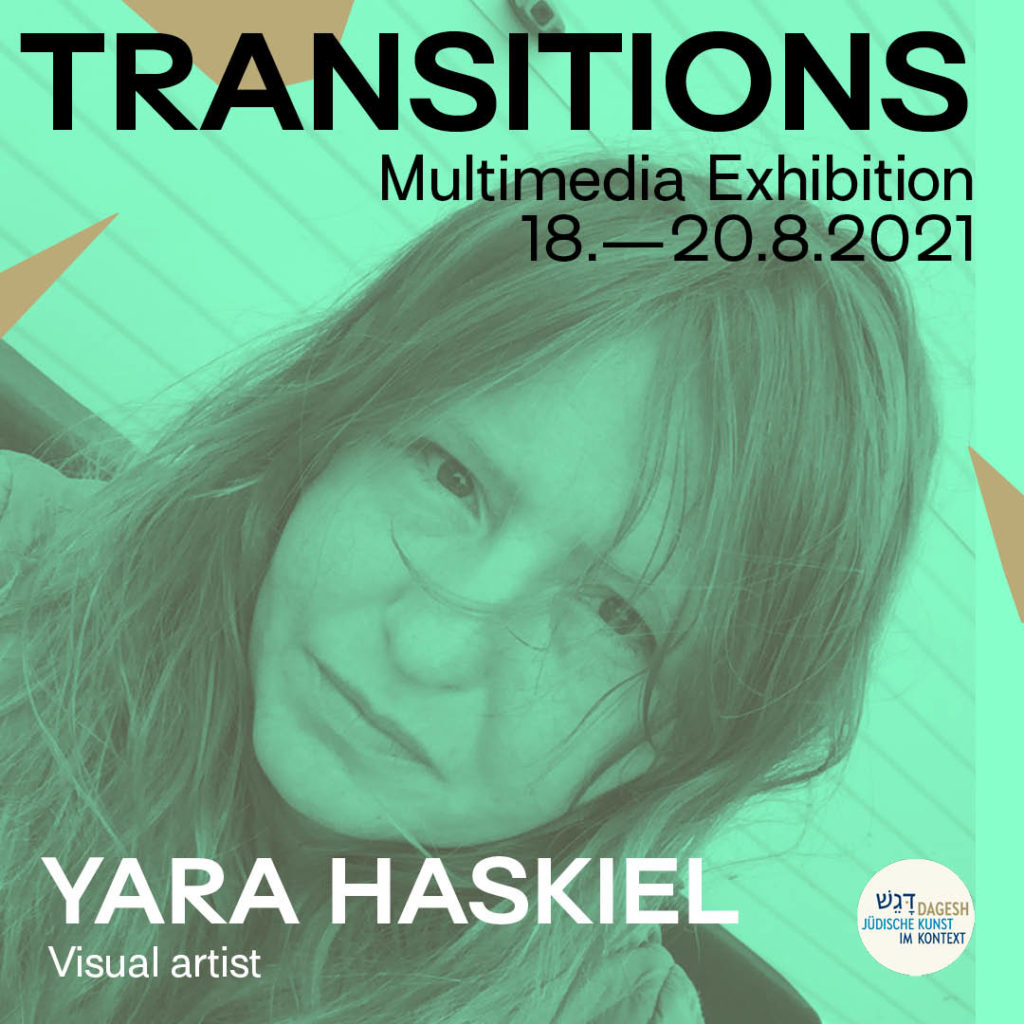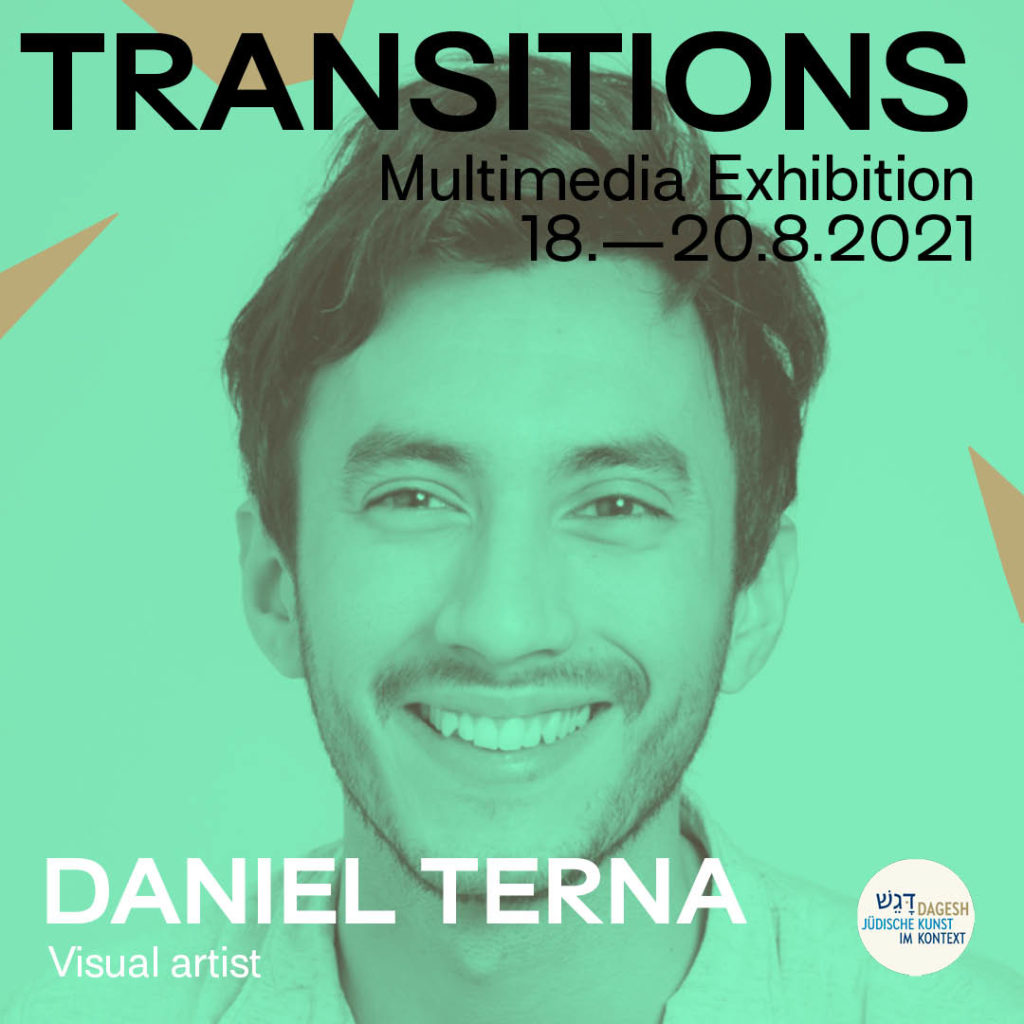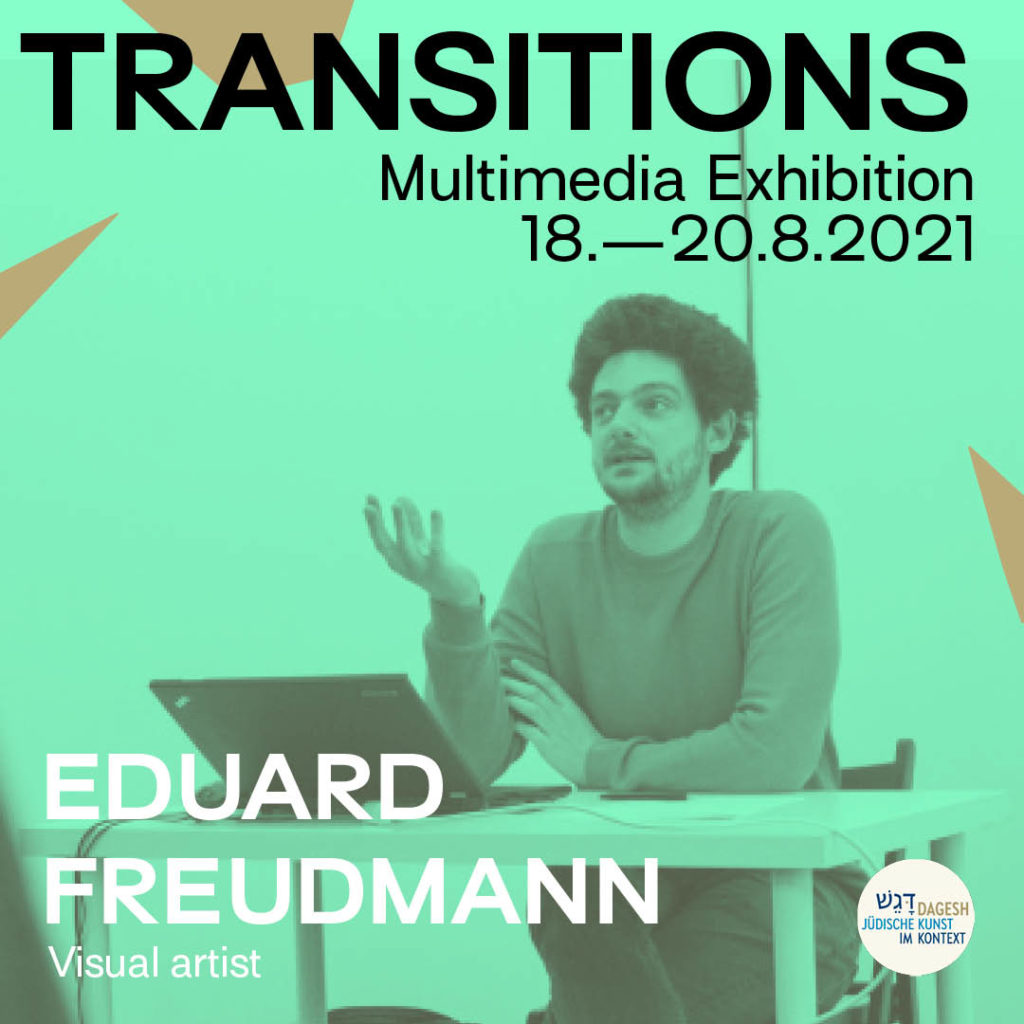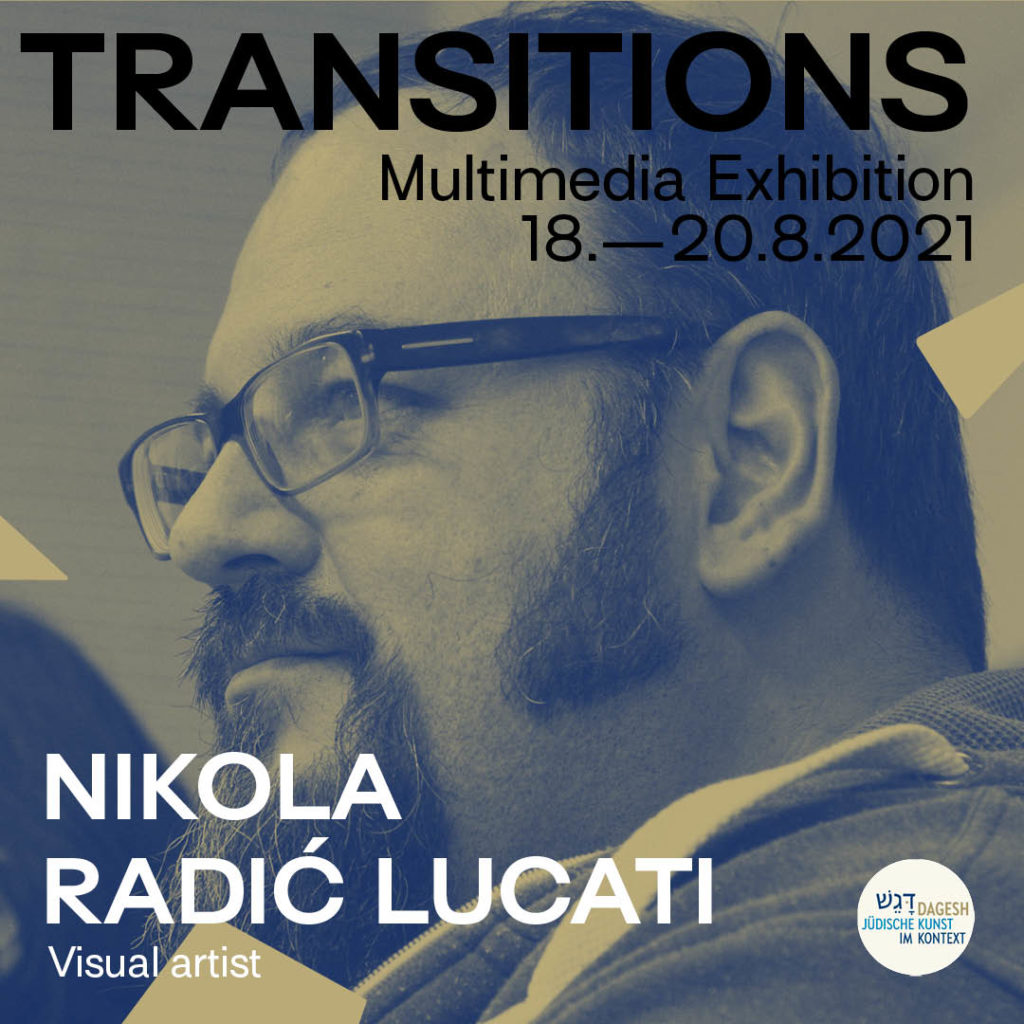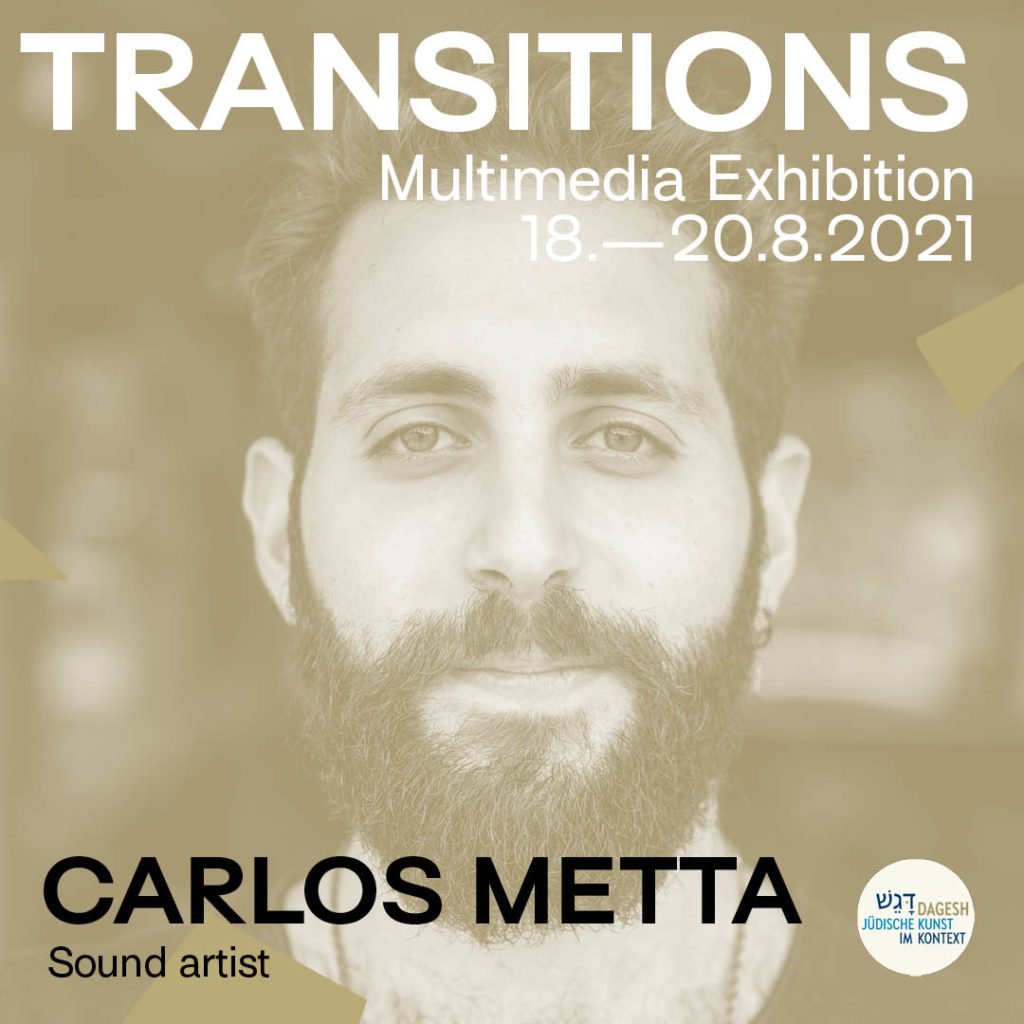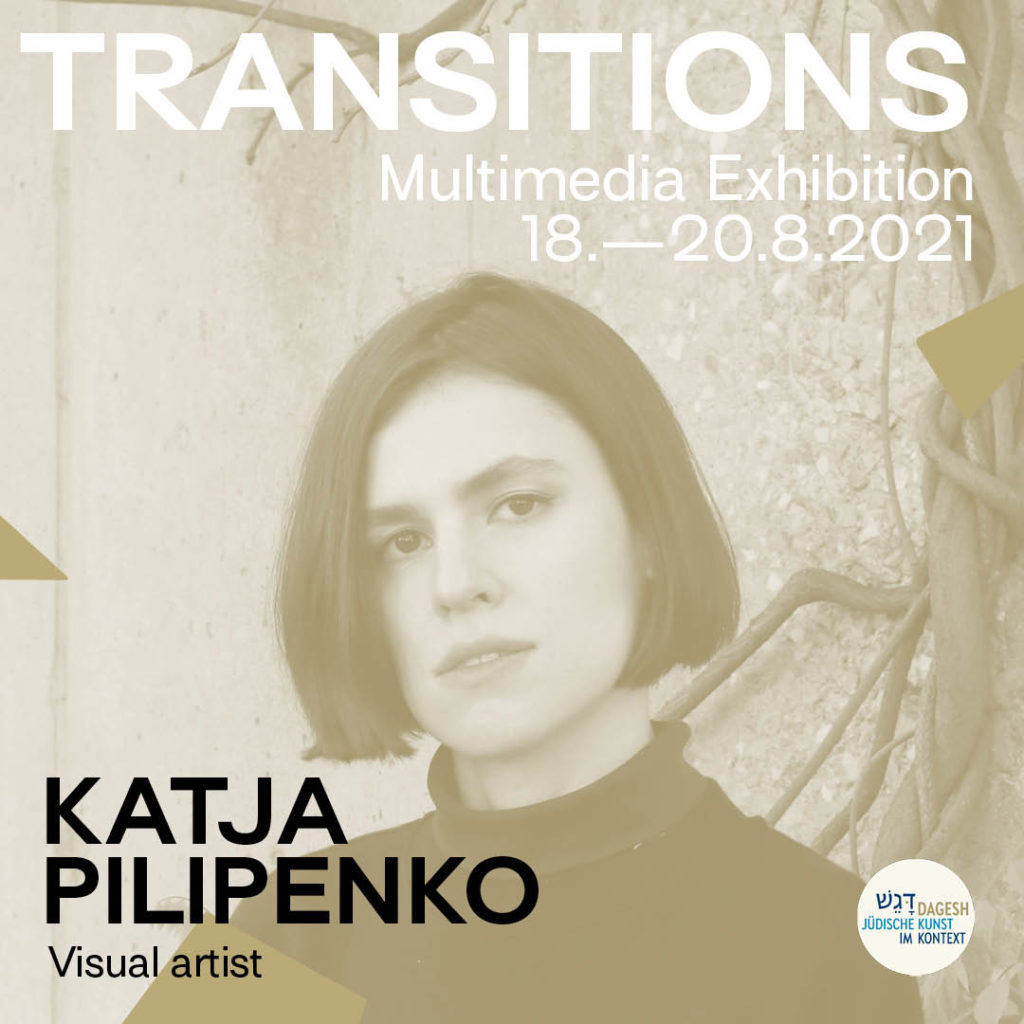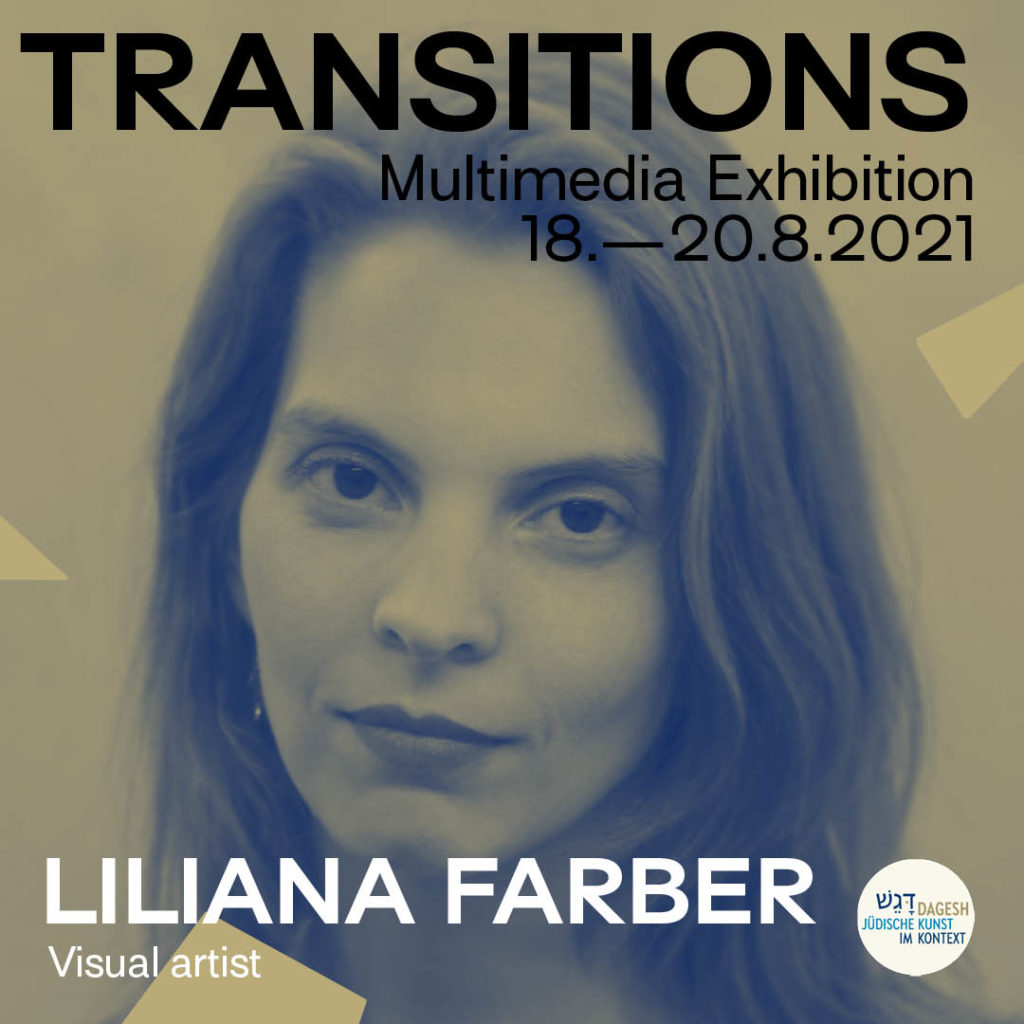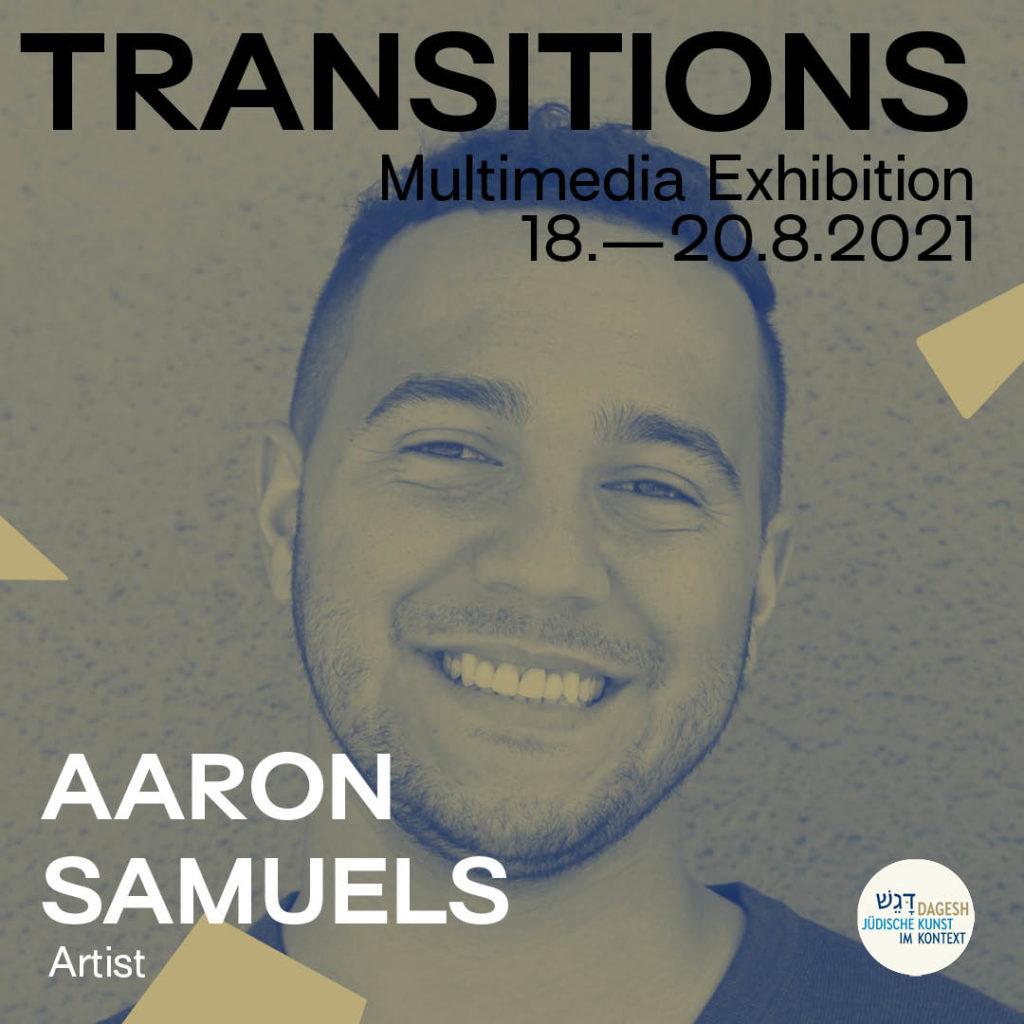Transitions
FESTIVAL JÜDISCHER GEGENWARTSKÜNSTE
Exhibition
»TRANSITIONS« – MULTIMEDIA ART EXHIBITION
»TRANSITIONS« seeks to create a new Jewish visibility that transcends borders in a European and transatlantic exchange. Via video and sound art, text composition, and other forms of visual and digital arts, over 15 artists will showcase their experience and understanding of solidarity and resistance through aesthetics and artistic practice from a shared and yet diverse contemporary Jewish perspective.
The concept of »TRANSITIONS« describes a liminal space, a threshold condition in which society currently finds itself, both socially and politically. A “betwixt and between” state, where the usual order of things is disrupted and new potentials and limits can be challenged and explored. With »TRANSITIONS« we seek to aesthetically explore ways to create newness founded on the very loss and (transgenerational) trauma of the original places. Speaking from a multiplicity of situated Jewish positions, the art pieces in the exhibition will display the artists’ engagement with political events, discourses and movements that impact and mobilise them in their specific context.
»TRANSITIONS« is in cooperation with and sponsored by:
Preface Jo Frank & Julia Y. Alfandari
Dear Guests, dear visitors of »TRANSITIONS«,
Art of Resistance (Wehrhafte Kunst) emphasizes art as social action, as a strategy of change. Art of Resistance calls for the transformation of discourse and society.
The term Wehrhaftigkeit is deeply connected with self-confidence and resistance. Art of Resistance takes the emancipatory potential of art seriously and challenges artists as well as the public to realize this potential.
The exhibition, which is part of »TRANSITIONS. Festival of Contemporary Jewish Arts« (18 – 20 August 2021), brings together artists from across Europe and the American continent. In their artistic practice, they explore and reflect on the liminal space, a threshold condition in which society currently finds itself, both socially and politically. The exhibition engages with this fragile „betwixt and between state“ where the usual order of things is disrupted. The works engage with the potential for change and seek aesthetic expressions to help shape the process of transition through the Art of Resistance.
The pandemic has shown us the interdependence and fragility of our world community. It has made global tipping points visible and has also confronted us all with unprecedented personal challenges. In this time of transition, global topics of the highest urgency are also negotiated in the works of Jewish artists: unequally distributed consequences of the climate crisis, questions about responsible globalization and perspectives concerning the seemingly antagonistic relationships between universalism and particularism. The strengths of identity politics are weighed against their risks, and current phenomena of anti-Semitism are addressed. The struggle against racism and the devaluation, exclusion and violence against people, who are marked as „Others“ are focused on. Furthermore, the artists explore central themes of the Jewish community and our society such as (post-)migrant experiences, the multifaceted nature of Jewish family histories, intergenerationality, the plurality of historical memory, religious traditions and contemporary spirituality.
One thing unites all works on show: They all encompass a yearning for collaboration, cooperation and coalitions. In this cooperative approach lies a key to the understanding of »TRANSITIONS«: Whoever expects a festival of contemporary Jewish art à la klezmer kitsch isolationism, will be disappointed. Jewish Art in Context is purposefully the subheading of Dagesh and cooperation is not a programmatic brief – it is a description of Jewish artists‘ reality and practice. The exhibition is also the result of months of conversations and intensive exchange between the artists.
The multimedia exhibition combines artistic forms ranging from video works to photography to sound art, that reinforce, challenge and question each other. The works speak from a multiplicity of situated Jewish positions, the art pieces in the exhibition display the artists’ engagement with political events, discourses and movements that impact and mobilise them in their specific context.
It is an exhibition emblematic of the described transitional phase. It is an exhibition of resistance.
Art of Resistance (Wehrhaftigkeit) is not a blunt belligerent gesture or aggression without consequence. Quite the contrary, it implies courage. The courage to raise one’s voice and to want to change society. This ability to resist can also be found where we might not expect it: in vulnerability, in spaces of pain, in traumata and collective grief. Art of Resistance can also be understood as artistic work against attempts to silence pain and intersectional memory; attempts pretending to be gentle and caring but which are in fact repressive. The art pieces shown in »TRANSITIONS« take a different path: the path of cooperation, of listening, of making “others” heard and visible, a path of ungentle defensiveness. Resilience and resistance in coalition. In the potential of plurality.
The plurality visible in our exhibition and also during the festival is not a harmonious plurality. The artists take up very different, often irreconcilable positions. They contradict each other, focus on different tipping points in their societies and communities. The internationality of the exhibition inevitably leads to a wide variety of represented discourses. In this context, a European or even a German discursive standpoint, does not wish and simply can not be dominant let alone exclusive. This curatorial decision, which is challenging for us all, is axiomatic: there is no one homogenous Jewish community, and so there can be no one form of Jewish Art, no one manifestation of Art of Resistance. However, something that all artists in this exhibition share is their will to take part in shaping society. We can accept the represented positions with enthusiasm, can agree with them, meet them with irritation, reject them or decide to listen to them, aware of their “otherness” – and still try to find ways of coming together. Engaging with the works on show gives us the opportunity to reflect on their and our own positions. Discuss with each other. Argue. With the goal of contributing to social change together, despite and also because of our differences. Dagesh stands for Machloket, dispute oriented towards gaining knowledge and evolving. And this is exactly what makes the pluralism we show, this discordant, dynamic and contradictory pluralism, into productive pluralism.
Dagesh deliberately decided to work in a sphere that is not simple, to break new ground and to take risks. This is only possible through the support of those, who work with us to create spaces, open and welcoming for such an enterprise. We would therefore like to thank in particular the German Foreign Office and the Allianz Cultural Foundation for their cooperation and support.
At the beginning, we welcomed you, dear guests, as visitors of the exhibition. In closing, we would like to correct ourselves: In this time, none of us is merely a visitors. We all have a responsibility in this liminal space and a role in shaping the transition.
If you would like to support Dagesh in this task, please contact us!
Jo Frank & Julia Y. Alfandari
Introduction Daniel Laufer
»TRANSITIONS« brings together fourteen art works by international artists, whose work grapples with intersections and dichotomies across world history and art history, politics and day-to-day Jewish culture. In their techniques and use of media, the artworks adopt photographic, audiovisual, and cinematographic frames of reference. From a variety of perspectives, contexts and forms, the “Wehrhaftigkeit” (resistance) in their artistic expressions is ingrained in all pieces. The works fall broadly into two thematic focus areas: first, transitions between (temporal) spaces, which are in a process of constant reevaluation and transformation, and second, transitions between language (sound) and words and images.
The artwork timeprotocol.net by Liliana Farber opens the exhibition space and modifies it. Temporal synchronization is the bedrock of electronic communication. The web application ‘Network Time Protocol’ is an artwork that displays the local time according to Halakha, Jewish religious law, rather than the UTC standard. The halakhic hour or relative hour (shaʿah zǝmanit,שעה זמנית) is the method by which time is calculated and the system for its perception under Jewish law. The piece offers a way to connect with other people via a culturally rooted method of time measurement.
Not only is time an abstract concept that structures our thinking, but as a kind of architecture, it also subdivides the concrete spaces we move through, spaces that we often only notice in passing. Across the exhibition, these same spaces are precisely investigated and radically reassessed: monuments are turned into cautionary memorials (Eduard Freudmann, Vigil of Disgrace); seemingly neutral public spaces suddenly mark the sites of Second World War atrocities (Hadas Tapouchi, Memory Practice); obscured locations from the Jewish community become visible again (Nikola Radić Lucati, Ethnographer’s Argument) and public spaces are transformed when a bush becomes a protagonist and conversation partner (Elianna Renner and Oree Holban, The Talking Bush). This element of dialogue carries over to the video art of Yara Haskiel (Precarious Twilight Zones) and Nikolay Karabinovych (Even further) as memories interact with their temporal, material and affective continuities and discontinuities.
The works by Daniel Terna (Fred) and the Krivoy Kolektiv (Chai Mikveh, The Four Mitzvot of the Queer, Soviet Jewish Diaspora) centre on the body itself, which moves through and is simultaneously structured by space and time. The human body consists of layers, membranes, substances, skin and surfaces. Bodies are organic, but they also bear deposits of history, traditions, images and words. The contribution by the Krivoy Kolektiv takes the Jewish ritual bath—a rite of passage through which a bather emerges from the water spiritually purified–and subjects it to a transformation of its own: a personal and individual experience becomes communal and collective.
In its second thematic focus, the exhibition explores transformation processes that are distilled into language, sound and words and are simultaneously shaped by and accompanied by them. Forty pairs of words – euphemisms and their literal meanings – constitute a visual poem (Katja Pilipenko, Synonyms). A sound map and narrative music composition capture an audible universe that describes a living environment, a culture, a comprehensive sound-identity (Nicolás Melmann, Spread). An intergenerational dialogue with the music of Simon & Garfunkel culminates in an imaginary response to the musicians (Tamara Michner, Old Friends). And finally, an audio artwork probes the relationship between Yom Kippur and the Black Lives Matter movement (Carlos Metta and Aaron Samuels, Forgiveness).
The space of »TRANSITIONS« is anything but static; it is a liminal space, a transition between two other locations, or states of being in constant flux where anything feels possible. These artistic perspectives open our eyes to the meanings of interstitial space while interrogating its obverse – fully conscious that in every transitory movement, something is lost and something else emerges anew.

